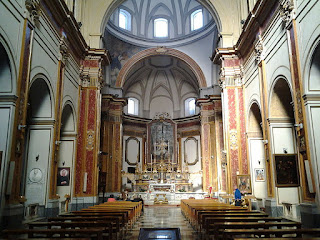Baroque musician known for his sense of humour
 |
| Leonardo Leo wrote or contributed to more than 70 operas, mainly comic |
His most famous comic opera was Amor vuol sofferenza - Love requires suffering - which he produced in 1739. It later became better known as La finta frascatana, and received a lot of praise, but Leo was equally admired for his serious operas and sacred music. He has been credited with forming the Neapolitan style of opera composition.
He was enrolled as a young boy as a student at the Conservatorio della Pietà dei Turchini in Naples and was a pupil first of Francesco Provenzale and later of Nicola Fago. It has been speculated that he may have been taught by Alessandro Scarlatti, but it has since been proved by music historians that he could not possibly have studied with the composer, although he was obviously influenced by his compositions.
Leo’s earliest known work was a sacred drama, L’infidelta abbattuta, which was performed by his fellow students in 1712, while he was still a teenager.
His first opera, Pisistrato, was produced at the court theatre in Naples in 1714 and was much admired.
As an adult Leo held various posts at the royal chapel in Naples while continuing to write for the stage and teach at the conservatory.
.png) |
| Leo was a major influence in the development of opera's Neapolitan school |
His most famous serious operas were Demofoonte (1735), Famace (1737) and L’Olimpiade (1737). With L’Olimpiade he became the first composer to introduce the chorus into Neapolitan opera.
Handel was so impressed with Leo’s opera, Catone in Utica, that he used some of the music from it in a performance at the King’s Theatre in London in 1732.
Leo died of a stroke in 1744 while he was composing new arias for a revival of his acclaimed opera, La finta frascatana.
Experts believe Leo was the first composer of the Neapolitan School to achieve a complete mastery over modern harmonic counterpart and agree that in his comic operas he reveals a keen sense of humour. He was to be one of the last major Italian Baroque composers and was well regarded as a teacher, with Niccolò Piccinni and Niccolò Jommelli among his students.
Leo wrote or contributed to about 70 operas, as well as composing oratorios, masses and instrumental works, some of which are still performed and are available on contemporary recordings. His Miserere (🎵Listen 🎵) for double choir and orchestra is regarded as his signature piece.
 |
| The Corso Leonardo Leo in San Vito dei Normanni is typical of the town's quaint narrow streets |
San Vito dei Normanni, where Leonardo Leo was born, is a town with a population of around 20,000, situated about 24km (15 miles) west of Brindisi in the area of Puglia known as Salento. An attractive town of narrow streets lined with baroque-style churches and palaces and numerous restaurants and bars, it was formerly known as San Vito degli Schiavoni on account of a large number of Slavs - Schiavoni in Italian - who settled in the area after migrating from Dalmatia, on the opposite side of the Adriatic, to escape persecution by the Saracens in the 10th century. The town’s history, though, dates back much further, with archaeological remains discovered that show the area was inhabited during the Bronze Age. Things to see include the medieval Castello di Dentice Frasso, sometimes known as the Castello di San Vito, which overlooks the main piazza, and the beautiful Baroque church of San Giovanni Evangelista, built in soft Lecce stone.
 |
| Inside the Church of the Pietà dei Turchini, which dates back to the time of the conservatory |
Founded in 1583, the Conservatorio della Pietà dei Turchini, where Leonardo Leo was a pupil, was the longest running of four Naples conservatories that were ultimately incorporated into the Real Collegio di Musica, which became the Conservatorio di San Pietro a Majella. Like the Conservatorio di Sant'Onofrio a Capuana, another of the four, it had been a charitable institution for the care of orphans and abandoned children. The church of the Pietà dei Turchini, which was built at around the same time as the conservatory, stands in Via Medina in the centre of Naples, not far from the Teatro di San Carlo opera house.
Also on this day:
1607: The birth of cardinal and arts patron Antonio Barberini
1623: The birth of composer Antonio Cesti
1953: The birth of Felice Casson - politician and magistrate
2002: The death of novelist Franco Lucentini
No comments:
Post a Comment